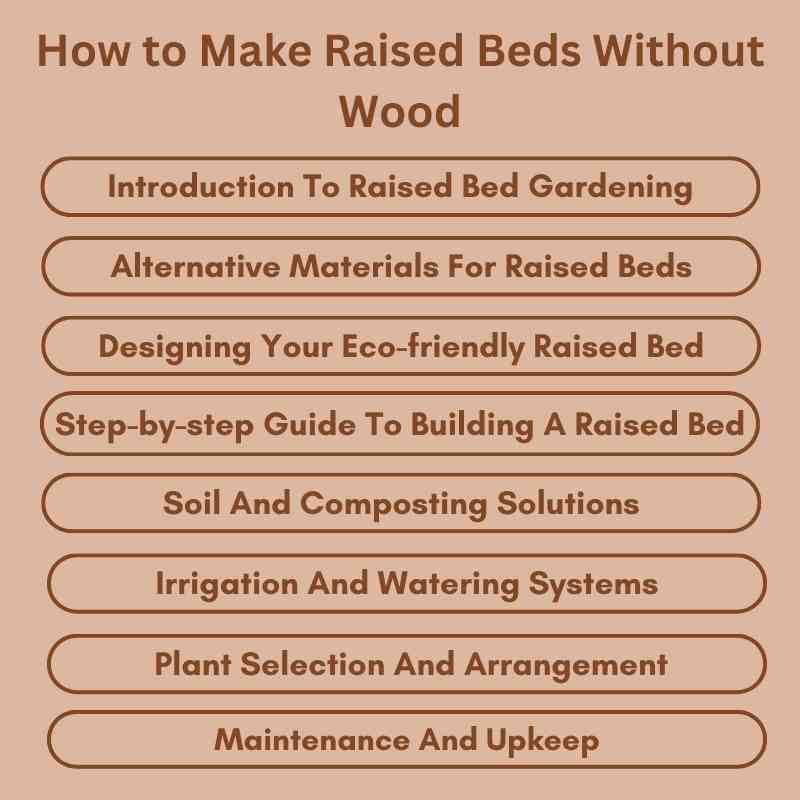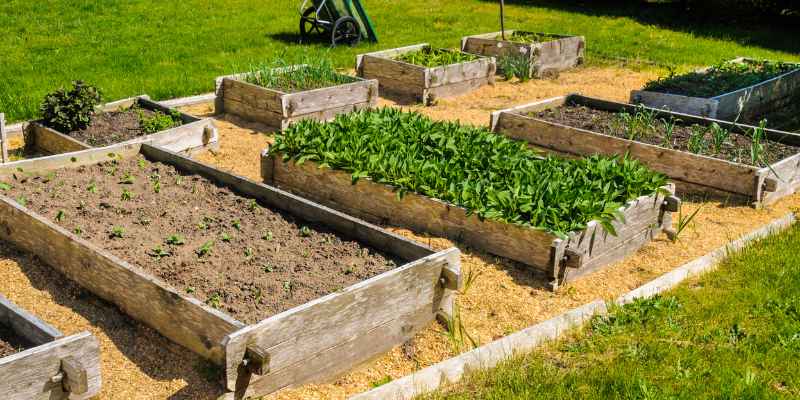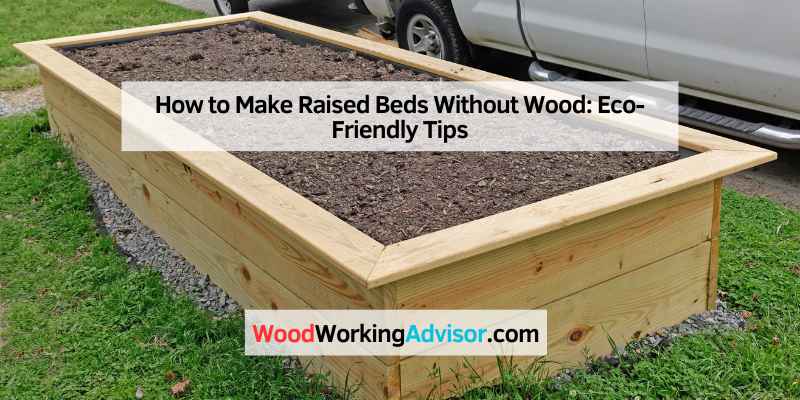To make raised beds without wood, use materials like bricks, stones, or concrete blocks. You can also opt for metal or recycled plastic to create sturdy sides.
Raised beds enhance gardening by improving drainage, soil quality, and accessibility. Many gardeners prefer these structures for their efficiency and ease of maintenance. Non-wood options offer durability and a modern aesthetic, making them perfect for various landscapes. Using materials like bricks or stones can create a beautiful and functional garden space.
These beds can be customized in size and shape to fit your yard. With a variety of choices available, it’s easy to find the right materials that suit your style and budget. Explore these alternatives for a sustainable and attractive garden solution.
Introduction To Raised Bed Gardening
Raised bed gardening offers many benefits. It improves drainage and soil quality. Plants grow healthier and stronger in these beds. Weeding becomes easier, saving time and effort.
Non-wood materials like bricks, stones, or metal can be great alternatives. They resist rotting and pests better than wood. Using recycled materials is also a sustainable choice. This helps the environment and saves money.
Raised beds made from non-wood materials can be very attractive. They come in various styles and colors. This adds aesthetic value to your garden. Enjoy gardening while being eco-friendly!

Alternative Materials For Raised Beds
Raised beds can be made using recycled plastic lumber. This material is durable and weather-resistant. It is also eco-friendly, as it uses waste plastic. No need for chemical treatments.
Natural stone and bricks are great options too. They provide a rustic look to any garden. Stones and bricks last a long time and add stability. They require little maintenance over time.
Galvanized steel is another strong option for raised beds. It resists rust and corrosion, making it very durable. Steel raised beds can be found in various sizes. They also heat up quickly, helping plants grow faster.
Designing Your Eco-friendly Raised Bed
Designing an eco-friendly raised bed starts with careful layout planning. Choose a spot with good sunlight and easy access. Think about how much space you need for plants.
Height and width matter for your raised bed. A height of 12 to 18 inches is great for most plants. Wider beds can help you grow more but make sure you can reach the center.
Drainage is key for healthy plants. Use a mix of soil and compost for better drainage. Adding rocks or gravel at the bottom helps excess water escape. This keeps roots safe from rot.
Step-by-step Guide To Building A Raised Bed
Start by selecting a flat area for your raised bed. Clear any weeds and debris from the site. Make sure the ground is level to ensure proper drainage.
Gather materials like bricks, stones, or metal sheets. These items will help create a sturdy structure. Use natural mulch or landscape fabric to keep weeds away.
Arrange the materials in a square or rectangle. Stack them securely to form the walls. Ensure the structure is stable and can hold soil and plants.
Soil And Composting Solutions
Creating a nutrient-rich mix is essential for raised beds. Combine topsoil, compost, and organic matter. Aim for a balance of 60% topsoil, 30% compost, and 10% organic materials. This mix provides healthy nutrients for plants.
Layering for optimal drainage is important. Start with larger materials like twigs at the bottom. Follow with smaller debris and finish with the nutrient-rich mix. This helps water flow well and prevents root rot.
Composting techniques can enhance your soil. Use kitchen scraps like fruit peels and vegetable ends. Add yard waste like leaves and grass clippings. Turn the pile every few weeks to speed up the process. After a few months, the compost will be ready.
Irrigation And Watering Systems
Drip irrigation is an efficient way to water raised beds. It delivers water directly to the roots. This method reduces water waste and promotes healthy plants. To install, lay out the drip lines in your garden. Connect them to a water source and adjust the flow. Regularly check for clogs to ensure proper function.
Rainwater harvesting collects and stores rain for irrigation. This sustainable method uses less municipal water. Set up a system with barrels or tanks. Place them under gutters to catch runoff. Use a filter to keep debris out. Connect the system to your raised beds for easy watering.
Plant Selection And Arrangement
Choosing compatible plants is essential for a successful raised bed garden. Start with plants that grow well together. For example, tomatoes and basil thrive side by side. Avoid planting carrots near dill as they may compete for nutrients.
Spacing is vital for growth and health. Plants need room to spread their roots. Follow the recommended spacing for each plant. This ensures they receive enough sunlight and water.
Seasonal planting strategies help maximize your harvest. Consider planting cool-season crops like lettuce in early spring. In summer, switch to warm-season crops like peppers. Rotate crops each year to maintain soil fertility.
Maintenance And Upkeep
Regular monitoring of raised beds helps catch problems early. Check soil moisture often. Look for signs of pests or diseases.
Use natural pest control methods to protect plants. Introduce beneficial insects like ladybugs. Remove any infected plants to prevent spread.
Seasonal bed preparation keeps plants healthy. Add compost each spring for nutrients. Rotate crops yearly to maintain soil quality.
Mulching helps retain moisture and suppress weeds. Ensure proper drainage to avoid waterlogging. Regularly check for any structural issues.
Benefits Of Going Wood-free
Raised beds without wood offer great longevity and durability. Materials like metal or stone resist weather and pests. These materials last longer than traditional wood beds.
Choosing wood-free options helps reduce environmental impact. Less deforestation occurs when using materials like recycled plastic. This choice contributes to a healthier planet.
Wood-free raised beds provide aesthetic versatility. They come in various colors and styles. This allows for unique garden designs that fit any home.

Frequently Asked Questions
How Do I Start A Raised Bed Without Wood?
To begin a raised bed without wood, choose a suitable location. Gather materials like bricks, stones, or recycled plastic. Create a rectangular or square shape using your chosen materials. Ensure proper drainage and fill the bed with quality soil. This method is eco-friendly and durable for your plants.
What Materials Can I Use For Raised Beds?
You can use various materials for raised beds, including concrete blocks, rocks, and recycled plastic. Metal sheets and old pallets also work well. Ensure the materials are safe and non-toxic for growing food. Using diverse materials adds an aesthetic touch and enhances garden functionality.
Are There Alternatives To Wood For Garden Beds?
Yes, there are several alternatives to wood for garden beds. Consider concrete blocks, stones, or bricks as sturdy options. Recycled materials like plastic or metal sheets are also effective. These alternatives provide durability and help you achieve a unique garden design without the drawbacks of wood.
How To Prevent Weeds In Raised Beds Without Wood?
To prevent weeds in raised beds, use a landscaping fabric or cardboard at the bottom. This barrier blocks sunlight and inhibits weed growth. Regularly mulch the surface with straw or wood chips. Additionally, maintain proper spacing between plants to discourage weed proliferation.
Conclusion
Creating raised beds without wood is an eco-friendly and innovative solution. You can use materials like stones, bricks, or even metal. These alternatives not only enhance your garden’s aesthetic but also provide durability. Start your raised bed project today and enjoy the benefits of sustainable gardening.
Happy planting!

